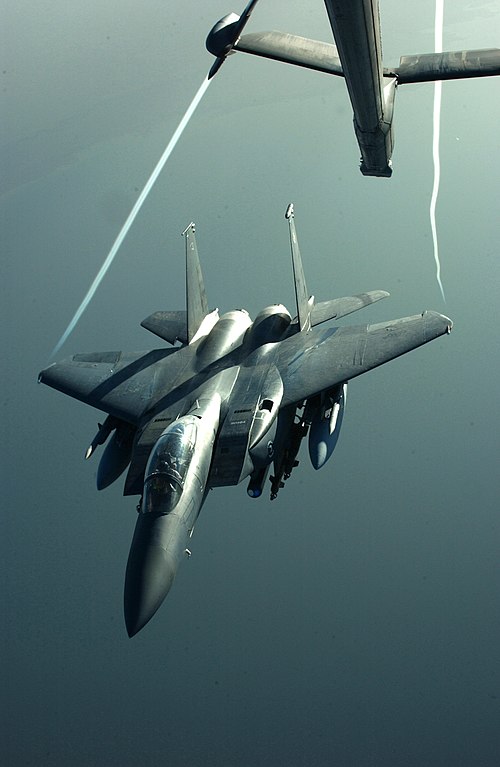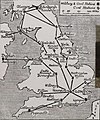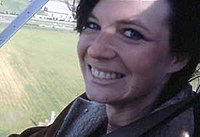Our website is made possible by displaying online advertisements to our visitors.
Please consider supporting us by disabling your ad blocker.
Portal:Aviation
| Main page | Categories & Main topics |
|
Tasks and Projects |
The Aviation Portal

Aviation includes the activities surrounding mechanical flight and the aircraft industry. Aircraft includes fixed-wing and rotary-wing types, morphable wings, wing-less lifting bodies, as well as lighter-than-air aircraft such as hot air balloons and airships.
Aviation began in the 18th century with the development of the hot air balloon, an apparatus capable of atmospheric displacement through buoyancy. Clément Ader built the "Ader Éole" in France and made an uncontrolled, powered hop in 1890. This is the first powered aircraft, although it did not achieve controlled flight. Some of the most significant advancements in aviation technology came with the controlled gliding flying of Otto Lilienthal in 1896; then a large step in significance came with the construction of the first powered airplane by the Wright brothers in the early 1900s. Since that time, aviation has been technologically revolutionized by the introduction of the jet which permitted a major form of transport throughout the world. (Full article...)
Selected article
Selected image
Did you know
...that a Fairchild C-119 Flying Boxcar was used in the 2004 film Flight of the Phoenix? ...that the Cessna 165 aircraft was instrumental in the recovery of the Cessna Aircraft Company in the years following the Great Depression? ... that before he flew the Spirit of St. Louis on his historic transatlantic flight, Charles Lindbergh's first choice of aircraft was the Ryan M-2?
General images -
In the news
- May 29: Austrian Airlines cancels Moscow-bound flight after Russia refuses a reroute outside Belarusian airspace
- August 8: Passenger flight crashes upon landing at Calicut airport in India
- June 4: Power firm helicopter strikes cables, crashes near Fairfield, California
- January 29: Former basketball player Kobe Bryant dies in helicopter crash, aged 41
- January 13: Iran admits downing Ukrainian jet, cites 'human error'
- January 10: Fire erupts in parking structure at Sola Airport, Norway
- October 27: US announces restrictions on flying to Cuba
- October 3: World War II era plane crashes in Connecticut, US, killing at least seven
- September 10: Nevada prop plane crash near Las Vegas leaves two dead, three injured
- August 6: French inventor Franky Zapata successfully crosses English Channel on jet-powered hoverboard
Related portals
Associated Wikimedia
The following Wikimedia Foundation sister projects provide more on this subject:
-
Commons
Free media repository -
Wikibooks
Free textbooks and manuals -
Wikidata
Free knowledge base -
Wikinews
Free-content news -
Wikiquote
Collection of quotations -
Wikisource
Free-content library -
Wikiversity
Free learning tools -
Wikivoyage
Free travel guide -
Wiktionary
Dictionary and thesaurus
Selected biography
Despite her surname, Jeana Yeager is not related to Chuck Yeager, the first man to break the sound barrier in level flight.
Selected Aircraft

The Airbus A340 is a long-range four-engined widebody commercial passenger airplane manufactured by Airbus. The latest variants (-600 & A340E) competed with Boeing's 777 series of aircraft on long-haul and ultra long-haul routes, but it has since been succeeded by the Airbus A350.
The A340-600 flies 380 passengers in a three-class cabin layout (419 in 2 class) over 7,500 nautical miles (13,900 km). It provides similar passenger capacity to a 747 but with twice the cargo volume, and at lower trip and seat costs.
The A340-600 is more than 10 m longer than a basic -300, making it the second longest airliner in the world, more than four meters longer than a Boeing 747-400.
- Span: 63.45 m (208 ft 2 in)
- Length: 75.30 m n(246 ft 11 in)
- Height: 17.30 m (56 ft 9 in)
- Engines: four 56,000 lbf (249 kN) thrust Rolls-Royce Trent 556 turbofans
- Cruising Speed: Mach 0.83 (885 km/h, 550 mph)
- First Flight: October 25, 1991
Today in Aviation
- 2011 – A Peruvian Air Force Zlin Z-242L crashed at Pisco airfield, Peru killing the two crew.
- 2011 – Manx2 Flight 7100 from Belfast, operated by Fairchild Swearingen Metroliner EC-ITP leased from Flightline BCN of Barcelona, overturns on its third attempt to land at Cork, Republic of Ireland in fog, killing six and injuring six.[1][2][3]
- 2010 – A Eurocopter AS350 helicopter of the Brazilian Army crashed while training tactical piloting maneuvering at Sao Pedro da Aldeia naval base, about 130 kilometers (81 mi) away from Rio de Janeiro city.
- 2009 – The communications satellites Iridium 33 and Kosmos-2251 collide in orbit 490 miles (789 km) above Siberia at a speed of 26,170 miles per hour (42,120 km/h).This was the first major collision of two satellites in Earth orbit. Both satellites were destroyed.
- 2004 – Kish Air Flight 7170, a Fokker 50, crashes at Sharjah International Airport, killing 43 people. Three survive with serious injuries.
- 2000 – Death of Igor Bensen, Russian born American engineer, founder of the Bensen Aircraft, which produced a successful line of Gyro-gliders (rotor kites) and Autogyros. He founded the Popular Rotorcraft Association in 1962, a non-profit interest group for owners and homebuilders of auto-gyros and helicopters, based in Mentone, Indiana.
- 1997 – Death of Amron Harry Katz, American physicist who specialized in aerial reconnaissance.
- 1995 – The prototype Antonov An-70 is destroyed after a mid-air collision with an An-72 chase plane. All seven aboard are killed in the crash.
- 1995 – Two Peruvian Sukhoi Su-22 Ms are shot down by a pair of Ecuadorian Mirage F.1JAs. Almost simultaneously, a Peruvian Cessna A-37 B is also shot down by an Ecuadorian Kfir C.2.
- 1993 – McDonnell Douglas produces its 10,000th aircraft
- 1991 – U. S. Navy A-6 Es sink two Iraqi Navy patrol boats in the northern Persian Gulf. Iraqi antiaircraft artillery shoots down a U. S. Marine Corps AV-8 B Harrier II over southern Kuwait.
- 1988 – The pilot of an General Dynamics F-16A Block 15J Fighting Falcon, 82–0909, c/n 61–0502, ejected safely when his plane caught fire and crashed on take-off at Moody Air Force Base in south Georgia. Problems occurred during a routine practice flight. Witnesses said the aircraft climbed straight into the air during take-off and exploded into flames before hitting the ground. The plane was assigned to Moody.
- 1982 – The flight of the Argus 10742 from Summerside to Rockcliffe for delivery to National Aviation Museum. The Argus overflew Canadair plant in a final salute.
- 1981 – Two United States Marine Corps helicopters (a CH-46 and a CH-53) collide over Tustin MCAS in California, United States, six killed.
- 1977 – Death of George John Dufek, American naval officer, naval aviator, and Arctic expert.
- 1975 – The Royal Australian Navy suffers its only operational Grumman S-2E Tracker loss during approximately 17 years of operation of the type when N12-153608 is lost at sea with two fatalities.
- 1971 – Death of Alfred Clayburn Atkey, Canadian WWI fighter ace.
- 1968 – Birth of Garrett Erin Reisman, American engineer and NASA astronaut.
- 1967 – First flight of the Dornier Do 31, a West German experimental VTOL jet transport.
- 1964 – The Royal Australian Navy aircraft carrier HMAS Melbourne (R21) collides with the destroyer HMAS Voyager (D04) during exercises off of Jervis Bay, Australia, slicing the destroyer in two and killing 82 of Voyager's sailors.
- 1964 – Death of Eugen Sänger, Austrian-German aerospace engineer best known for his contributions to lifting body and ramjet technology.
- 1963 – Death of Isidore Auguste Marie Louis Paulhan, known as Louis Paulhan, pioneering French aviator who flew “Le Canard”, the world's first seaplane.
- 1962 – American U-2 pilot Gary Powers, shot down and arrested in the U. S. S. R. May 1st 1960, is exchanged along with American student Frederic Pryor in a well publicized spy swap for Soviet KGB Colonel Vilyam Fisher (aka Rudolf Abel), a Soviet colonel who was caught by the FBI and put in jail for espionage, at the Glienicke Bridge in Berlin, Germany.
- 1953 – Death of William Spurrett Fielding-Johnson, British WWI flying ace.
- 1952 – Maj George A. Davis Jr is awarded the Medal of Honor posthumously, after attacking a group of 12 Mikoyan-Gurevich MiG-15s that were about to bounce other US aircraft. He shot down two before being shot down himself.
- 1949 – USAF Douglas A-26B-66-DL Invader, 44–34719, out of Greenville AFB, South Carolina, piloted by Robert L. Kenyon, crashes at Waples Pond, Delaware - four killed.
- 1945 – German Junkers Ju 88s attack Convoy JW 64 in the Arctic Ocean.
- 1944 – American Airlines Flight 2, a Douglas DC-3, crashes into the Mississippi River for reasons unknown, killing all 24 occupants (21 passengers and 3 crew members).
- 1943 – A U. S. Army Air Forces Antisubmarine Command B-24D Liberator sinks a German submarine, apparently U-519, in the North Atlantic Ocean, the first submarine sunk by the command.
- 1942 – A Hawker Hurricane Mk. I, P3664, of No. 55 OTU, based at RAF Usworth,[109] crashes in bad weather in an orchard opposite the High Marley Hill Radio Mast, killing RCAF Sergeant Pilot James D’Arcy Lees Graham, 24, of Carstairs, Alberta. The Air Ministry Crash Card records that the fighter flew into high ground in a squall, the weather deteriorated and the aircraft dived out of low cloud into a snow squall and failed to pull out of the dive. The pilot was interred at St Margaret's Church Cemetery, Castletown, Sunderland.
- 1941 – Britain uses paratroops for the first time in an attack on Tragino
- 1941 – (overnight) – 222 British bombers attack Hanover, Germany, losing seven of their number, and 43 others attack oil storage tanks in Rotterdam in the Netherlands. In the Rotterdam raid, the Short Stirling makes its combat debut as the United Kingdom's first four-engined heavy bomber.
- 1936 – First flight of the Fiat BR.20, an Italian low-wing twin-engine medium bomber.
- 1935 – First flight of the A. N. F. Les Mureaux 180, a French Single engine High wing monoplane 2 seat fighter prototype, evolution of the ANF Les Mureaux 170.
- 1933 – First flight of the Hawker Demon
- 1930 – An Air Union Farman F.63 Goliath crashes while attempting an emergency landing at Marden Airfield, Marden, Kent due to structural failure, killing 2 of 6 on board.
- 1929 – Evelyn “Bobbi” Trout broke the record for the first all-night flight by a woman as well as and the new women's solo endurance record flying more than 17 hours in an open cockpit Bruner Winkle biplane .Trout flew from Mines Field USA.
- 1925 – The 1030 hrs. crash of a Curtiss JN-6H, AS-44806, ~2 miles (3.2 km) E of Brooks Field, Texas, kills instructor 1st Lt. Arthur L. Foster along with Maj. Lee O. Wright. Foster Field at Victoria, Texas is later dedicated to the pilot on 22 February 1942. Foster's widow, Mrs. Ruth Young Foster, of San Antonio, Texas, unveiled a plaque that read "Dedicated to the memory of Lieut. Arthur Lee Foster, a pioneer in aviation who gave his life teaching others to fly." Foster Field was designated Foster Air Force Base on an inactive status on 1 September 1952, by Department of the Air Force General Order No. 38, dated 29 August 1952.
- 1925 – Pacific Airways Ltd. was formed by D. R. MacLaren and took over the fishery patrol from the RCAF.
- 1923 – An experimental night flight arrives to Le Bourget, France, from Croydon, England. The pilot has given his position by radio and used the aviation light beacons to make his approach.
- 1914 – Berliner, Haase and Nikolai land their free balloon in Perm, setting a new distance record of 3053 km from Bitterfeld.
- 1913 – Birth of Federico Cozzolino, Italian Aviator.
- 1903 – Birth of George John Dufek, American naval officer, naval aviator, and Arctic expert.
- 1898 – Birth of Thomas Sydney Chiltern, British WWI flying ace.
- 1897 – Birth of Erik Thomas, German WWI flying ace.
- 1892 – Birth of Roland Rohlfs, American early aviator and test pilot.
- 1891 – Birth of Air Marshal Sir William Lawrie Welsh KBE, DSC, AFC, British Royal Air Force officer who commanded British air operations during Operation Torch and also a WWI RNAS Pilot.
References
- ^ "Belfast flight crashes at Cork Airport". RTÉ. Retrieved 10 February 2010.
- ^ "EC-ITP Accident description". Aviation Safety Network. Retrieved 10 February 2011.
- ^ Hradecky, Simon. "Accident: Flightline SW4 at Cork on Feb 10th 2011, failed landing in low visibility". Aviation Herald. Retrieved 10 February 2011.
- Shortcuts to this page: Portal:Airplanes • P:AVIA
Previous Page Next Page
























































